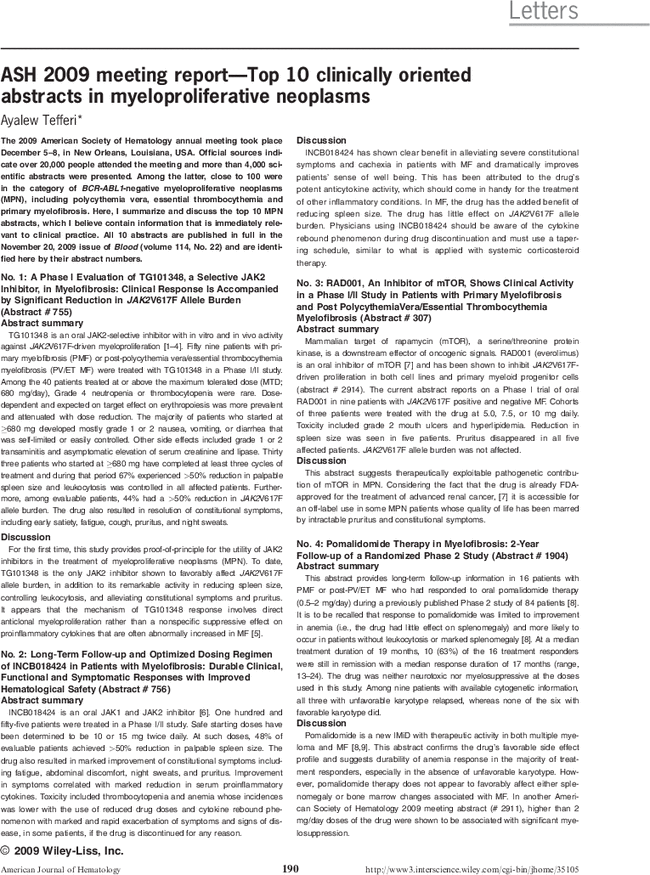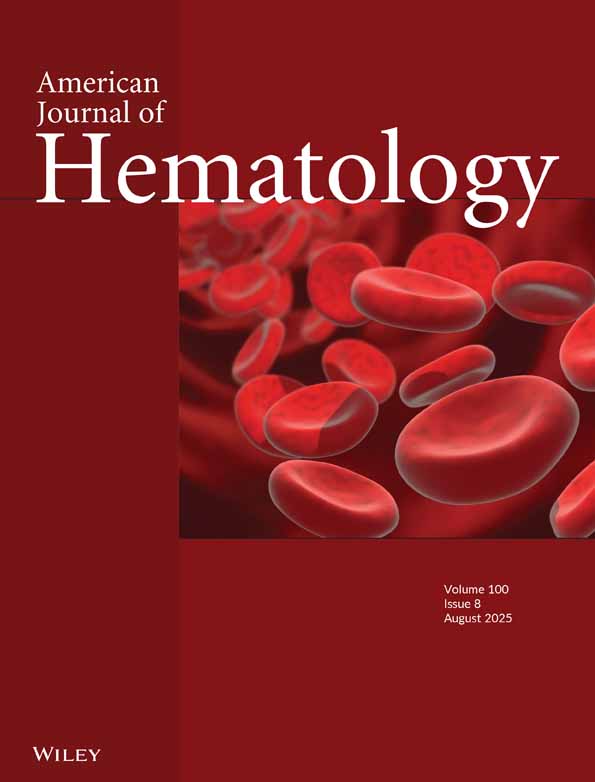Letter
Free Access
ASH 2009 meeting report—Top 10 clinically-oriented abstracts in hematopoietic stem cell transplantation
David L. Porter,
Corresponding Author
David L. Porter
Blood and Marrow Transplantation, Division of Hematology-Oncology, University of Pennsylvania Medical Center, Philadelphia, Pennsylvania 19104
Blood and Marrow Transplantation, Division of Hematology-Oncology, University of Pennsylvania Medical Center, 3400 Civic Center Boulevard, PCAM 2 West Pavilion, Philadelphia, PA 19104Search for more papers by this authorDavid L. Porter,
Corresponding Author
David L. Porter
Blood and Marrow Transplantation, Division of Hematology-Oncology, University of Pennsylvania Medical Center, Philadelphia, Pennsylvania 19104
Blood and Marrow Transplantation, Division of Hematology-Oncology, University of Pennsylvania Medical Center, 3400 Civic Center Boulevard, PCAM 2 West Pavilion, Philadelphia, PA 19104Search for more papers by this author
References
- 1 Aversa F,Terenzi A,Tabilio A, et al. Full haplotype-mismatched hematopoietic stem-cell transplantation: A Phase II study in patients with acute leukemia at high risk of relapse. J Clin Oncol 2005; 23: 3447–3454.
- 2 Riley JL,June CH,Blazar BR, et al. Human T regulatory cell therapy: Take a billion or so and call me in the morning. Immunity 2009; 30: 656–665.
- 3 Saiko K,Takahiro F,Kinuko T, et al. Outcome of 93 patients with relapse or progression following allogeneic hematopoietic cell transplantation. Am J Hematol 2009; 84: 815–820.
- 4 Loren AW,Porter DL. Donor leukocyte infusions for the treatment of relapsed acute leukemia after allogeneic stem cell transplantation. Bone Marrow Transplant 2008; 41: 483–493.
- 5 Vago L,Perna SK,Zanussi M, et al. Loss of mismatched HLA in leukemia after stem-cell transplantation. [see comment]. New Engl J Med 2009; 361: 478–488.
- 6 Martino R,Iacobelli S,Brand R, et al. Retrospective comparison of reduced-intensity conditioning and conventional high-dose conditioning for allogeneic hematopoietic stem cell transplantation using HLA-identical sibling donors in myelodysplastic syndromes. Blood 2006; 108: 836–846.
- 7 Flynn CM,Hirsch B,Defor T, et al. Reduced intensity compared with high dose conditioning for allotransplantation in acute myeloid leukemia and myelodysplastic syndrome: A comparative clinical analysis. Am J Hematol 2007; 82: 867–872.
- 8 Tomblyn M,Brunstein C,Burns LJ, et al. Similar and promising outcomes in lymphoma patients treated with myeloablative or nonmyeloablative conditioning and allogeneic hematopoietic cell transplantation. Biol Blood Marrow Transplant 2008; 14: 538–545.
- 9 de Lavallade H,El-Cheikh J,Faucher C, et al. Reduced-intensity conditioning allogeneic SCT as salvage treatment for relapsed multiple myeloma. Bone Marrow Transplant 2008; 41: 953–960.
- 10 Estey E,de Lima M,Tibes R, et al. Prospective feasibility analysis of reduced-intensity conditioning (RIC) regimens for hematopoietic stem cell transplantation (HSCT) in elderly patients with acute myeloid leukemia (AML) and high-risk myelodysplastic syndrome (MDS). Blood 2007; 109: 1395–1400.
- 11 Valcarcel D,Martino R,Caballero D, et al. Sustained remissions of high-risk acute myeloid leukemia and myelodysplastic syndrome after reduced-intensity conditioning allogeneic hematopoietic transplantation: Chronic graft-versus-host disease is the strongest factor improving survival. J Clin Oncol 2008; 26: 577–584.
- 12 Tauro S,Craddock C,Peggs K, et al. Allogeneic stem-cell transplantation using a reduced-intensity conditioning regimen has the capacity to produce durable remissions and long-term disease-free survival in patients with high-risk acute myeloid leukemia and myelodysplasia. J Clin Oncol 2005; 23: 9387–9393.
- 13 MacMillan M,Weisdorf D,Wagner J, et al. Response of 443 patients to steroids as primary therapy for acute graft-versus-host disease: Comparison of grading systems. Biol Blood Marrow Transplant 2002; 8: 387–394.
- 14 Mathias C,Mick R,Grupp S, et al. Soluble interleukin-2 receptor concentration as a biochemical indicator for acute graft-versus-host disease after allogeneic bone marrow transplantation. J Hematother Stem Cell Res 2000; 9: 393–400.
- 15 Weissinger EM,Schiffer E,Hertenstein B, et al. Proteomic patterns predict acute graft-versus-host disease after allogeneic hematopoietic stem cell transplantation. Blood 2007; 109: 5511–5519.
- 16 Song KW,Lipton J. Is it appropriate to offer allogeneic hematopoietic stem cell transplantation to patients with primary refractory acute myeloid leukemia? Bone Marrow Transplant 2005; 36: 183–191.
- 17 Oyekunle AA,Kroger N,Zabelina T, et al. Allogeneic stem-cell transplantation in patients with refractory acute leukemia: A long-term follow-up. Bone Marrow Transplant 2006; 37: 45–50.
- 18 Weisser M,Ledderose G,Jochem Kolb H, et al. Long-term follow-up of allogeneic HSCT for CML reveals significant improvement in the outcome over the last decade. Ann Hematol 2007; 86: 127–132.
- 19 Zerr DM,Corey L,Kim HW, et al. Clinical outcomes of human herpesvirus 6 reactivation after hematopoietic stem cell transplantation. Clin Infect Dis 2005; 40: 932–940.




